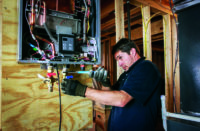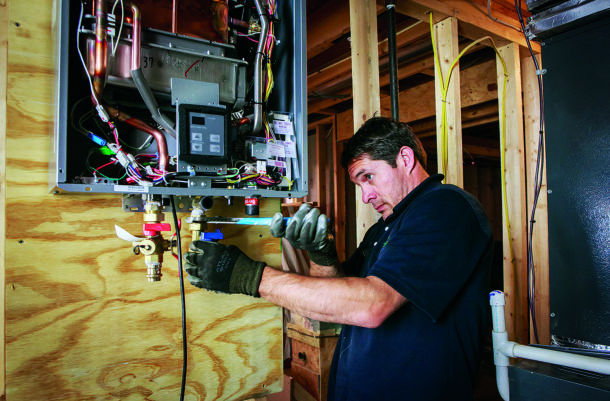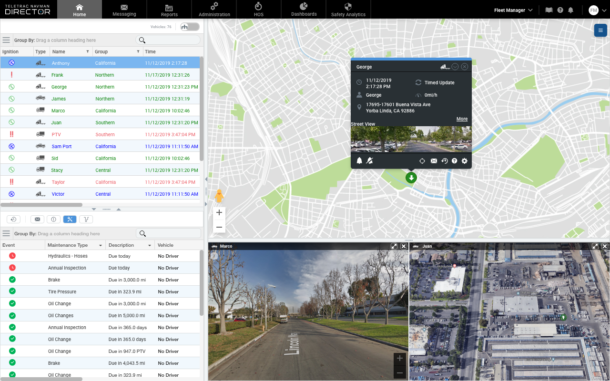Hydronic heating offers complete, energy-saving system for homeowners When your customers are selecting home appliances, what priorities often drive their decision making? If the answer is cost, comfort, or environmental impact, they may be interested to learn more about hydronic systems, which offer efficient home and hot water heating simultaneously. When it comes to hydronic Read more
Industry Blogs

Hydronic heating offers complete, energy-saving system for homeowners
When your customers are selecting home appliances, what priorities often drive their decision making? If the answer is cost, comfort, or environmental impact, they may be interested to learn more about hydronic systems, which offer efficient home and hot water heating simultaneously.
When it comes to hydronic heating, there are different options: the hydronic furnace and in-floor hydronic radiant heat, which is most commonly used for homes in cold climates.
Here’s an overview of how one of these systems works and how they can benefit both you and your customers.
What is a hydronic furnace?
Hydronic furnaces connect seamlessly to select tankless water heaters and condensing boilers to deliver efficient, simultaneous home heating and domestic hot water in one complete system. Hydronic furnaces use hot water from a tankless water heater, saving installation costs—and making traditional furnaces seem like a thing of the past. By pairing them with propane-powered water heater, contractors can help their customers enjoy steady, comfortable heat throughout their home.
A propane-powered tankless water heater supplies continuous hot water—unlike a traditional storage tank with a capacity of just 50 or 75 gallons and required time to recover between uses—so the system can pump a constant flow through the heating coil and deliver steady, comfortable heat to the home without the need for a fuel-powered furnace, gas piping or an extra exhaust vent to the atmosphere. At the same time, the tankless water heater performs its primary job without interruption, prioritizing heating the water that is piped to showers, sinks, dishwashers, and washing machines.
These systems can be installed in a new home or added to an existing home and can be paired with an air-source heat pump to maintain comfort and efficiencies—even on cold days when the heat pump can’t keep up. Plus, this does away with the super in-efficient resistant heat coil for the emergency heat mode.

How can this technology benefit my customers?
With a hydronic furnace, homeowners can rely on steady, comfortable heating throughout their home, saving space, energy, and money.
Budget-friendly
A tankless water heater is typically more expensive than a traditional storage tank model, but some manufacturers offer the hydronic air handler for less than a comparable gas-powered condensing furnace. When you combine that with installation savings you end up with a lower cost installed product. Plus, because propane-powered tankless water heaters only heat water when it’s needed, they can help homeowners save more than $150 per year in energy costs when compared with typical electric storage tank water heaters.
Increased comfort and control
Comfort is one of the biggest perks of hydronic heating. In fact, many homeowners report that their heat is less dry than heat radiated via a traditional furnace. With a hydronic furnace, homeowners control the air temperature by setting a thermostat, just as they would with a traditional furnace or heat pump.
Sustainable operation
And for environmentally conscious homeowner customers, they can have peace of mind knowing their system is reducing emissions compared with other energy options. Notably, a propane tankless water heater produces roughly half of the carbon emissions of an electric storage tank system when full lifecycle emissions are taken into consideration. Plus, they’re aiding in water conservation efforts because hydronic systems create no wastewater. Instead, they take the water used to heat the air and recirculate it through the tankless water heater.
How can installing hydronic heating benefit my business?
The benefits of hydronic heating don’t stop with the customer. Plumbing and HVAC contractors can reap the benefits, too. The dual technology presents an opportunity for some plumbers to get into the heating business and some mechanical contractors to add tankless water heater installation to their line of services.
Some industry pros predict that builders will embrace hydronic heating as homebuyers already familiar with the benefits of energy- efficient tankless water heaters learn that those energy- and water-saving devices can also help heat their homes.
Visit Propane.com/Water-Heating to learn more.
 Bryan Cordill is director of residential and commercial business development for the Propane Education & Research Council. He can be reached at bryan.cordill@propane.com.
Bryan Cordill is director of residential and commercial business development for the Propane Education & Research Council. He can be reached at bryan.cordill@propane.com.

Employee satisfaction and motivation is a topic that has been discussed since the creation of Maslow’s Hierarchy of Needs. Employees are the backbone of any organization and an essential part of a company’s ability to be successful and grow. Maintaining a level of satisfaction is key if you want to have any measure of success Read more
Employee satisfaction and motivation is a topic that has been discussed since the creation of Maslow’s Hierarchy of Needs. Employees are the backbone of any organization and an essential part of a company’s ability to be successful and grow. Maintaining a level of satisfaction is key if you want to have any measure of success as a business owner.
Keeping employees feeling satisfied and motivated remains a pain point for many in the mechanical world. Technicians are currently in high demand across the home service industry, creating little downtime in an environment that is suffering from a labor shortage. The COVID-19 pandemic created a perfect storm that resulted in more HVAC unit breakdowns and longer days for technicians.
During the apex of the pandemic, many employees across multiple industries had to work from home. Units that would normally get a break while the house was empty were now working an additional eight hours a day. That is the equivalent of driving a car 75,000 miles a year. With the added wear-and-tear on units, service calls increased dramatically.
The combination of more service calls and a limited supply of professionals attributed to workers in the mechanical world feeling stressed and unsatisfied. More service calls also meant long drive times while combating both the physical and mental elements that come with the job – working in the hot sun or communicating with an angry customer.
When it comes to our profession, employees rarely get stressed over the actual repair process. Oftentimes, the stress comes from all the outside factors that would put a mental strain on the worker. But there are ways to help motivate and encourage employees to perform their tasks while remaining engaged.
The Employee Experience
In our line of work, we tend to put our primary focus on the customer experience and making the customer happy. While these actions help drive revenue, we don’t need to forget the importance of employee satisfaction. Our team members are the greatest assets we have. I discovered a long time ago that if you take care of the employees, they will in turn take care of the customers.
Taking care of the employee means more than just offering them a decent paycheck. It encompasses a wide range of areas. It means providing the necessary equipment to ensure safety as well as giving the job a purpose. For example, a heating and air company I worked for purchased an ice machine so team members wouldn’t have to purchase ice to fill up their coolers every morning. We also made healthy snacks and drinks available throughout the day. That was just one small gesture we made to keep our employees satisfied.
All of these items help create loyalty. A team member will not want to leave if they feel like they are being taken care of regularly. The moment they feel differently, they will become disengaged and leave you for someone offering a dollar more per hour.
A Path to Success
One of the best ways to motivate an employee is to give them a purpose. That includes providing an individual career path. Many individuals working in the mechanical world don’t have a real career path. Their life revolves around a continuous cycle that includes doing similar tasks daily. So, if business owners can discover what success looks like to the employees, they can help them achieve their goals through a detailed career plan. On the flip side, this allows owners to hold the employee accountable to key performance indicators.
In addition to a career path, business owners should help inform employees financially. While compensation is a great motivator, it isn’t the only sticking point for most people. Providing tools that allow team members to be educated about financial matters shows that you care about their future outside of work. Teach employees how to set money aside, save and invest in their future.
The Power of Positive Reinforcement
Another mitigating factor in motivation is determining what motivates the entire team. It is important to communicate with team members about what they want and what can encourage them to perform at their best. More times than not, the team members will be honest in their responses. One example I have pertains to the use of contests and prizes. One company I was working with in Florida had a big special going on to see how many service agreements they could sell. For each agreement that was sold, the employee got to put their name in a raffle for some great prizes. The reward for selling an increased amount of service agreements greatly outweighs the cost of the prizes, and it got team members motivated to go out and sell, sell, sell.
Creating a Positive Culture
I believe business is a function of its people. You’ve got to take care of your people. We need to stop focusing on what we are not getting right and start focusing on the 99% of the things we excel in. We can still talk about the things that need improvement or can be done differently, but we’ll have that conversation in a private one-on-one setting. As a team, we need to celebrate the wins. It’s about enforcing the behavior that you want to see in your company. I’m always trying to create a positive culture, and all my actions reflect that. For business owners, the majority of their focus should be geared toward creating the desired behaviors they want because that’s where they will get the results.
 Stephen Dale is director of training for Power Selling Pros. Stephen brings over 20 years of experience as an operations manager in the home services industry working for two large MEP companies in the Dallas area. He has been a coach and trainer with Power Selling Pros for six years, working with hundreds of companies and vendors during his tenure. His passion for the industry illuminates through his ability to discover client’s pain points and offer solutions for success.
Stephen Dale is director of training for Power Selling Pros. Stephen brings over 20 years of experience as an operations manager in the home services industry working for two large MEP companies in the Dallas area. He has been a coach and trainer with Power Selling Pros for six years, working with hundreds of companies and vendors during his tenure. His passion for the industry illuminates through his ability to discover client’s pain points and offer solutions for success.

We all see those posts on chat boards about, “My phone doesn’t ring, I’m desperate, what should I do?” Even those of you who have been in business for a few years have those dry spells don’t you? So, what do you do? You don’t throw a gazillion dollars into SEO marketing, get a new website or Read more
We all see those posts on chat boards about, “My phone doesn’t ring, I’m desperate, what should I do?” Even those of you who have been in business for a few years have those dry spells don’t you? So, what do you do? You don’t throw a gazillion dollars into SEO marketing, get a new website or get a new Facebook page. The reason all that doesn’t help is because you run out of money before it can start to work. Statistics say that you have to see an ad seven to 35 times before you call for the product or service. That’s why you see the same commercials over and over on TV. But who can afford that?
Marketing and advertising are good, of course. You need your name out there. So how do you get business fast? You must understand that we are in a very different situation today than a lot of us grew up with. Here’s what’s different now:
- Customers in most of the USA only want to know three things:
- Will you answer the phone?
- Will you show up?
- Will you actually do the work if I say yes?
- It’s so hard to get a contractor to do even one of those things, when 30 years ago it was a given that all three would take place. It’s not about money anymore, it’s about finding someone to do the work. As long as your price isn’t crazy, you should get the job. The number of actual companies with call takers, dispatchers, managers and service techs is closer to 10% now, compared with 80% that was the norm 30 years ago. But Facebook advertising makes the one-truck guy often look like the big company. That means the technician is trying to fix your equipment, while taking calls for three more service jobs. Not only is that not professional, it means your equipment is not getting his full attention. He is going to do a quick fix and likely still charge you as if he actually tested it completely before closing it up.
- The companies that do have management staff are often only concerned with sales numbers. This means they are pushing the techs to sell sell sell and get done fast. This has been the worst thing for the service industry, and it is a big reason manufacturers are going full steam into DIY equipment, like mini-splits.
- And here is one of the toughest changes. When you don’t have a part for your customer, who’s fault is it? Today, it’s the fault of a system that has some holes in it. Here’s an example. Yesterday I got a hankering for a peach iced tea, so I stopped into one of those gas stations with the huge convenience store. Their choices were massive, but there was no Snapple Peach Tea. I finally chose some other brand of tea, but not peach. When the only cashier in this huge store finally showed up, I asked her if they normally carry Snapple products. She pointed to a cooler that was mostly empty. “That’s the Snapple area, but the distributor can’t find any drivers so we have to wait.” Imagine that, a distributor who can’t get products delivered to them because somewhere out there a bunch of people just don’t want to work. These are really different times.
So how do you get work today when your phones won’t ring?
In this economy the customers are desperate, waiting days and sometimes weeks to find a skilled tradesman. They are tired of unanswered phones, broken promises, and time wasted waiting for someone to show up. So, here’s the fastest way to get business when you need it today. Get on the telephone – pole. Yes, staple your message on telephone poles in neighborhoods you want to work in. Place yard signs on corners going into neighborhoods you want to work in. Your message should be simple, because it is for the frustrated people who can’t get an HVAC guy or plumber to call them back.
“We Fix Air Conditioning”
Call (number)
Simple as that.
Your yard sign can be prettier with your logo, but make sure the phone number is big. Why does it work? Because they see it seven to 35 times. And they see it when they need someone right now. So, they call.
The beginning of friendship marketing is “Get business IN the neighborhood that you want to work in!”
Now, once you start getting work and you like the neighborhood, then get something you can set on the driveway on the driver’s side. When they come home, they see it. Why is that so special? Because what do people look for when they come home today, that they didn’t 30 years ago? Packages from Amazon. They are already looking for a package, so make one for them.
About the package:
- It doesn’t have to actually look like an Amazon package. Be creative.
- If you are a plumber, set out a plunger with your name and phone number laminated to the handle.
- If you are not a plumber, you can still use the plunger because it’s an excellent place to zip-tie a zip lock bag with your stickers, coupons, gifts, nice stuff. Who doesn’t like gifts?
- Inside the bag should be a magnet that says, “My Personal Cell Phone Number” then your number.
- Do NOT put candy in the bag, because pets will think it’s for them.
- Don’t be salesy or give out coupons like every other company. It is time for someone different. The goal is to be the neighborhood’s friend. Make a “Get out of the heat free!” card for AC, with a line under it that says, “Free service call with repair.” That last phrase has worked for 30 years, and still does.
- If you don’t use a plunger, you can use a 2’ long pole of some kind. But if you are going to stick something in someone’s yard, you better put something nice in it.
- You can test ads, test yard signs, test phone pole signs, test driveway gifts. Test test test. You will be the only one doing it.
When you have selected particular neighborhoods, your marketing can be targeted and directed to that neighborhood. This skyrockets the efficiency of your marketing dollar. Why is that so important? Because efficient marketing can be sustained, and you don’t run out of money. What else do you need to know? Getting the customers you want is spelled w-o-r-k. Here’s the good news: it’s pretty easy work, easier than crawling through attics. Ask me, I know.
 Pricing enthusiast Rodney Koop is the founder and CEO of The New Flat Rate, a home service menu-selling system designed to put profit directly into the hands of plumbing, electrical, and HVAC contractors. Rodney can be reached at (706)581-0622 or rodney@menupricing.com.
Pricing enthusiast Rodney Koop is the founder and CEO of The New Flat Rate, a home service menu-selling system designed to put profit directly into the hands of plumbing, electrical, and HVAC contractors. Rodney can be reached at (706)581-0622 or rodney@menupricing.com.

Dain Hansen is vice president of Government Relations, The IAPMO Group. He lends his frequent perspective of Capitol Hill, and the plumbing industry. Here is an edited version of his update from July 30, 2021: Congressional Update. Finally, an Infrastructure Bill. The House passed an infrastructure bill Thursday that would direct more than $700 billion Read more
 Dain Hansen is vice president of Government Relations, The IAPMO Group. He lends his frequent perspective of Capitol Hill, and the plumbing industry.
Dain Hansen is vice president of Government Relations, The IAPMO Group. He lends his frequent perspective of Capitol Hill, and the plumbing industry.
Here is an edited version of his update from July 30, 2021:
Congressional Update.
Finally, an Infrastructure Bill. The House passed an infrastructure bill Thursday that would direct more than $700 billion over five years for roads, railways, electric vehicles, and water, with Democrats set to use the policy to negotiate on a broader infrastructure package. The bill (H.R. 3684), passed in a largely party-line vote of 221-201, faced opposition from Republicans who criticized climate provisions and a lack of funding measures. The passage comes a week after a bipartisan group of senators and President Joe Biden agreed on a separate, nearly $1 trillion infrastructure framework that includes baseline spending.
But combining the proposals and coming to an agreement on how to pay for the legislation will be a heavy lift. Several authorizing committees in both chambers have jurisdiction over infrastructure, with different ideas for how to implement policy. Adding to the urgency is a Sept. 30 deadline to reauthorize surface transportation programs, regardless of whether a larger infrastructure deal is cut. DeFazio said the House bill and Senate bipartisan agreement are “within shouting distance” on spending levels, but that the Senate proposal is only a broad outline that lacks any detailed policy proposals.
The House measure includes historic levels of investment for drinking and wastewater infrastructure. The legislation would authorize $53 billion over the next decade for the Drinking Water State Revolving Fund, and $40 billion through fiscal 2026 for the Clean Water State Revolving Fund, which provides low-cost loan financing to communities for a range of water infrastructure projects. The Clean Water fund has not been reauthorized since 1988, though appropriators fund the critical program each year. The funds comprise the bulk of the water infrastructure investment in the bill. The bill also would include another $45 billion to fully replace lead service lines throughout the country. President Biden will have to use his clout to sell the bill to Democrats who don’t think it does enough on infrastructure and green energy.
After the Infrastructure Bill, the Budget Resolution. Many Democrats on Capitol Hill are more interested in a second package focused on climate change and social spending. The Senate will turn to a $3.5 trillion budget resolution once it passes the bipartisan infrastructure bill. Approving the budget resolution is a necessary first step in passing that large package of domestic spending and tax increases in the fall through the budget reconciliation process, which only requires a majority vote in the Senate (the process sidesteps the usual 60 vote procedural threshold for most legislation). Senate Democrats should be able to get all 50 of their members to support the resolution, though it is clear that some moderate Democrats like Senator Kyrsten Sinema (D-AZ) are unlikely to support the full $3.5 trillion of spending. Consequently, Democrats likely will need to lower the amount of spending in the bill. Even a smaller-scale bill will include a massive amount of spending that would be funded by significant increases in taxes on businesses and wealthier individuals. Votes in the Senate and House on this spending package (as on the bipartisan infrastructure package) will be close, and the possibility of a failed vote cannot be dismissed.
Unhappy Progressives. One dynamic that could tank these two bills is the increasing unhappiness of more progressive members of the Democratic caucus in both the House and Senate. They think the bipartisan infrastructure bill doesn’t do enough to support spending on green energy, and mass transit or to promote union work requirements. They also are unhappy with Senator Sinema’s opposition to a $3.5 trillion spending bill since many progressives saw that as a low water mark for spending. Even after the passage of a $1.9 trillion COVID relief bill earlier this year, progressives want to “go big” on domestic spending and thought that their new majorities in the House and Senate would pave the path forward to do so. It will be up to President Biden to calm this intra-party frustration and get the party behind these measures.
State and Local Update.
Legionnaires Cases Spike in Chicago. The Chicago Department of Public Health is investigating after 49 cases of Legionnaires’ disease were reported in Chicago since July 1, resulting in 15 hospitalizations and two deaths. This month’s case count represents a substantial increased compared to the last two years, with 16 total cases reported in 2020 and 13 in 2019, according to CDPH. No common source has been identified.
A Drought So Dire That a Utah Town Pulled the Plug on Growth. Oakley, about an hour’s drive east of Salt Lake City, imposed a construction moratorium on new homes that would connect to the town’s water system. It is one of the first towns in the United States to purposely stall growth for want of water in a new era of megadroughts. But it could be a harbinger of things to come in a hotter, drier West. Groundwater and streams vital both to farmers and cities are drying up. Fires devour houses being built deeper into wild regions and forests. Extreme heat makes working outdoors more dangerous and life without air-conditioning potentially deadly.
While summer monsoon rains have brought some recent relief to the Southwest, 99.9 percent of Utah is locked in severe drought conditions and reservoirs are less than half full. Yet cheap housing is even scarcer than water in much of Utah, whose population swelled by 18 percent from 2010 to 2020, making it the fastest-growing state. Oakley is planning to spend as much as $2 million drilling a water well 2,000 feet deep to reach what officials hope is an untapped aquifer. But 30 miles north of Oakley, near the Echo Reservoir—28% full and dropping—is the town of Henefer, where new building has been halted for three years. Right now, Henefer is trying to tap into new sources to provide water for landscaping and outdoor use—and save its precious drinking water. Cities across the West worry that cutting off development to conserve water will only worsen an affordability crisis that stretches from Colorado to California.
Water now looms over many debates about building. Water authorities in Marin County, Calif., which is contending with the lowest rainfall in 140 years, are considering whether to stop allowing new water hookups to homes. Developers in a dry stretch of desert sprawl between Phoenix and Tucson must prove they have access to 100 years’ of water to get approvals to build new homes. But extensive groundwater pumping—mostly for agriculture—has left the area with little water for future development. “Water will be and should be—as it relates to our arid Southwest—the limiting factor on growth,” said Spencer Kamps, the vice president of legislative affairs for the Home Builders Association of Central Arizona. “If you can’t secure water supply, obviously development shouldn’t happen.”
Santa Clara, California Unveils Aggressive New Water Conservation Plan. Last month, the Santa Clara Valley Water District declared a drought emergency, urging cities and customers to cut water usage by 15 percent. The city of Santa Clara’s plan gets specific. The conservation plan limits landscape watering to three days a week with an elaborate system based on even and odd numbered addresses. It also bans washing driveways, sidewalks, porches and parking lots with water. Additionally, people are prohibited from washing their cars or boats unless their hose has an automatic shutoff valve. It also requires restaurants to only serve water to customers who request it. “When the water comes out just to warm up for your shower, we’re actually pouring that water into a bucket and using that to water our plants,” said homeowner Denise Gonzales.
Experts Tell New Mexico Lawmakers Swift Action Needed to Address Dwindling Water Supply. As of this week, about half of New Mexico was in extreme or exceptional drought conditions, according to the U.S. Drought Monitor. It was worse a month ago, before recent rains brought some relief. Gov. Michelle Lujan Grisham has convened both a drought task force and climate change task force to look for ways to mitigate the problem over the next five years. Noting the state’s reliance on water compacts with other states to get and give water, Sen. Joe Cervantes, D-Las Cruces, said: “This is about economics. In the end, water will be about money.”

Wireless network technology is continuing to evolve, and members of the transportation industry who have come to rely on 3G networks for telematics in their connected vehicles have to consider how they’re going to keep up, lest they get left behind. Driven by ever-growing demands for more and faster data, major network providers are working Read more
Wireless network technology is continuing to evolve, and members of the transportation industry who have come to rely on 3G networks for telematics in their connected vehicles have to consider how they’re going to keep up, lest they get left behind.
Driven by ever-growing demands for more and faster data, major network providers are working ceaselessly on their respective rollouts of the fifth generation of mobile network capabilities, known as 5G, promising greatly reduced latency along with incredible speed and the ability to transmit large amounts of data in much reduced time. At the same time, the 3G networks are being phased out, with most networks set to go offline next year. Current 3G hardware is incompatible with the newer networks, and fleets that don’t upgrade in time will find themselves in the dark before long.

3G’s Clock is Ticking
Fortunately for fleet owners, there is still time to make the transition. Of the biggest providers, only AT&T is currently set to sunset 3G early next year – in February – with both Sprint and Verizon planning their shutdowns for December 2022.
Those dates come with a caveat, however: depending on the region, existing 3G infrastructure isn’t guaranteed to last until the sunset date, as regular maintenance may be dropped in favor of implementing hotly demanded 4G and 5G infrastructure instead.
Faced with uncertainty, fleet owners would be wise to get ahead of this technological leap. This is especially true for fleets that are using electronic logging devices (ELD). No fleets are more at risk of being negatively impacted by this change than those mandated to use ELDs. If these fleets fall offline, the systems will no longer be accurately tracking hours of service, and the drivers will be non-compliant, introducing a risk of those vehicles being pulled from service. To make this jump correctly, companies must carefully craft an internet of things (IoT) strategy that accounts for these newer, high-speed networks. Doing so will require implementation planning, cost analysis and training, giving all the more reason to act quickly.
The Benefits of Modern Hardware
Newer technology introduces greater functionality that will undoubtedly come in handy in the regular operation of a fleet. Even going from one step from 3G to 4G, the improvement will be immediately noticeable. Further futureproofing for 5G will ensure fleet owners stay at the forefront of technology for decades to come, all while enjoying the smoothest experience possible as the new networks roll out. The perks of being on a cutting-edge network are myriad, but highlights include:
- Faster speed and a wider network mean more reliable connections, particularly in areas where the wireless network is congested.
- Improved latency allows for sending a large mass of data such as alerts and events, including data-heavy content such as video.
- Communications between connected vehicles and the surrounding infrastructure is far more reliable and operate in close to real-time on high-speed connections providing instant information from the fleet and drivers.
- Massive amounts of data can be fed into AI-enabled telematics systems, turning real-time data into actionable safety, efficiency and compliance gains.
The key takeaway is that moving to new hardware isn’t a needless burden, but a net gain for a fleet’s drivers, customers and bottom line. Owners who get ahead now will avoid challenges down the line and reap the benefits above in the meantime.

The Road Ahead
Adopting 4G and 5G capable hardware is both an exciting opportunity and a growing requirement as older networks sunset, but the biggest reason for fleet owners to get started sooner is to make sure they have time to do it right. In the coming months, owners will want to take the following steps:
- Determine how many devices are still on the 3G network, and how many need to be migrated.
- Understand what kind of lifecycle to expect from new telematics equipment.
- Research modern telematics speed- and data-focused features made possible by new hardware, including AI and machine learning options, and consider how they can improve the fleet’s operation.
- Discuss the upgrade with the fleet’s telematics provider and learn about modern telematics and future facing solutions.
- Discover whether or not the telematics provider is charging their current customers for this type of upgrade, this can give you a glimpse into how they will handle related future tech refreshes.
- Ensure the new hardware is properly certified and has a pathway to helping companies with their regulatory requirements such as ELD or other regional specific programs
- Schedule the necessary vehicle downtime to make the upgrade with the minimum possible impact on downtime.
- Once everything is in place, implement a migration plan well ahead of your wireless network provider’s 3G sunset period.
These steps will take time, and fleet owners will want to feel confident in every step of the process. As such, waiting until the last minute to get started on the transition is ill-advised. Moving up from 3G isn’t as easy as flipping a switch. However, those owners who do put in the effort will avoid having to worry about their telematic systems potentially going out on them, crippling their essential dataflow for safety, compliance and business efficiency.
Now is the time to check with your telematics provider about the imminent 3G sunsetting or find a new vendor who can handle the inevitable upgrade.
 Guest Blog By Andrew Rossington
Guest Blog By Andrew Rossington
Andrew Rossington joined Teletrac Navman in February 2016, working first as Vice President of Transtech (Division) before becoming Vice President, Transport Solutions in February 2018 then onto becoming Chief Product Officer in October 2020. In this role, Andrew is responsible for all transport industry solutions, including product development, go to market, team development and financial responsibilities. Since joining the business, he has overseen year-on-year growth in the transport vertical across the Australia/New Zealand region of Teletrac Navman. Prior to this, Andrew was the Chief Executive Officer for Transtech, which was acquired by Teletrac Navman. He has spent the last 20 years focused on transport industry solutions and has extensive experience managing software development teams and implementing key business systems for some of Australia’s largest transport operators and software companies, including Toll, ComTech and Dimensions Data. He is passionate about the transport industry and using technology to enable successful business outcomes.

 Guest Blog By Andrew Rossington
Guest Blog By Andrew Rossington